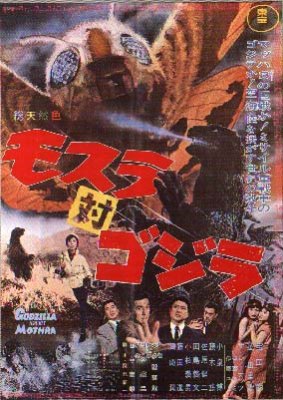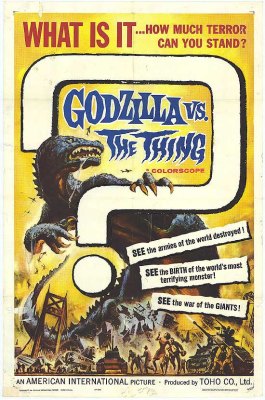| Reviews & Columns |
|
Reviews DVD TV on DVD Blu-ray 4K UHD International DVDs In Theaters Reviews by Studio Video Games Features Collector Series DVDs Easter Egg Database Interviews DVD Talk Radio Feature Articles Columns Anime Talk DVD Savant Horror DVDs The M.O.D. Squad Art House HD Talk Silent DVD
|
DVD Talk Forum |
|
|
| Resources |
|
DVD Price Search Customer Service #'s RCE Info Links |
|
Columns
|
|
|
Mothra vs. Godzilla / Godzilla vs. The Thing
Godzilla's first sequel, Godzilla Raids Again (aka Gigantis the Fire Monster, 1955) had been a quickie B-picture designed to cash in on the enormous popularly of its predecessor. In its original form the third Godzilla movie, King Kong vs. Godzilla (1962), was basically a glossy salaryman comedy with monsters, in many ways closer in spirit to Abbott and Costello meet Frankenstein than the original Godzilla. (The stars of that film, Tadao Takashima and Yu Fujiki, had become a Hope & Crosby-type team in that singularly Japanese comedy subgenre about the country's white collar work force. Salaryman comedies, not kaiju eiga, were Toho's primary genre throughout the '50s and '60s.) In Mothra vs. Godzilla, Godzilla is once again the terrible, unstoppable menace; gone are the clownish, tag-team wrestling hijinks of King King vs. Godzilla.
But Mothra vs. Godzilla is also a sequel to another Toho movie, 1961's Mothra (Mosura). That film had been a modern day fairy tale cum satire on western-style commercialism and consumerism run amuck - it was a popular subject in Japanese movies at the time, as depicted in such films as Yasuzo Masumura's Giants and Toys (1958) - and these themes are likewise carried over into Mothra vs. Godzilla.
When a gigantic egg suddenly appears offshore after a massive typhoon, greedy opportunist Kumayama (Yoshifumi Tajima), acting as a front for shady moneyman Torahata (Kenji Sahara), buys the egg from local fishermen, intending to make it the centerpiece of a big theme park. The egg, however, belongs to the guardian of the vaguely Polynesian Infant Inland, the behemoth insect Mothra. The creature's two tiny priestesses (twins Emi and Yumi Ito, "The Peanuts") plead for the egg's return.
With the help of reporter Ichiro (Akira Takarada), his protegee newspaper photographer Junko (Yuriko Hoshi), and scientist Miura (Hiroshi Koizumi), the foot-tall twin fairies make their case before Kumayama and Torahata. Not only do the men refuse but outrageously offer to "buy" the fairies from the Japanese trio. Meanwhile, it turns out that Mothra's egg isn't the only Thing that's washed ashore. At the site of an industrial development, Godzilla suddenly appears and soon is trashing Nagoya, one of Japan's biggest cities.
For all its slickness and crowd-pleasing spectacle, Mothra vs. Godzilla is much darker than both Mothra and King Kong vs. Godzilla, and much more intelligent than it's usually given credit for. Where Mothra's villain had been a thinly-disguised Ugly American, Kumayama and Torahata symbolize Japanese vice at its worst, men who bend laws intended to protect individuals to their own advantage. (Asked to return the egg, Torahata smugly replies, "Are you Mothra's power of attorney?") However, what's really terrific about Shinichi Sekizawa's script is that they're but the tip of the iceberg in our modern, corrupt world. There's a photo-op savvy politician (Kenzo Tabu) who boasts about how much he cares about his constituents one minute while trying to put the kibosh on Miura's radiation testing the next because it may delay his big industrial development project (and the implied kick-backs accompanying it). Ichiro's editor (Jun Tazaki) has old-fashioned attitudes about his newspaper's duty to champion its readers' causes, but Ichiro pessimistically notes that all its editorials against Kumayama and Torahata have merely provided them with free publicity. That Godzilla heads straight for Nagoya's industrial center is no accident: seven years before Godzilla fought the Smog Monster Japan was already fast becoming aware of the detrimental health effects of the air pollution spewing out of its factories' smokestacks.
Even our three heroes aren't spared some of the blame. Rushing to Infant Island to ask Mothra to come to Japan's defense against Godzilla, they find that the lush tropical paradise of the first Mothra has through western world nuclear testing become a barren, toxic rock in the middle of the ocean, with but one tiny oasis left to support its population of understandably bitter natives.
The film's surprising intelligence is matched by what in 1964 were state-of-the-art special effects. Tsuburaya and his team offer such a barrage of miniatures and optical effects that some inevitably are more realistic or artistically successful than others, but most of it is visually quite spectacular. The Godzilla costume (inhabited once again by Haruo Nakajima) never looked better: this is the iconic Godzilla suit, full of menacing personality, while Nakajima's effective pantomiming is brings it to life.
Tsuburaya's blending of his special effects shots with director Ishiro Honda's live action footage is seamless, particularly some early scenes where the tiny fairies run around Torahata's hotel suite as Kumayama tries to capture them, and later in many impressively ambitious traveling mattes that matte the Peanuts into live action footage both behind and in front of them.
Unlike the radically altered U.S. versions of the first three Godzilla movies, Godzilla vs. The Thing is almost identical in tone and content to the Japanese original. Except for some very minor trimming by original distributor AIP, the main difference is that the U.S. version actually has one extra sequence shot in Japan by Toho but used only in the export version: a joint U.S.-JDF naval assault on Godzilla with Frontier Missiles.
Video & Audio
Mothra vs. Godzilla and the American version, Godzilla vs. The Thing are presented in 16:9 enhanced format on a single-sided, dual-layered disc. Mothra vs. Godzilla is presented in its original Toho Scope format (OAR: 2.35:1) using a clone of the same master Toho Video used for their April 2003 Region 2 DVD. For whatever reason, Toho's transfers of its 'scope titles tend to run a little soft, possibly in an effort to hide some of the age-related wear in its pre-print material. The image is strong, but one gets the sense it could be sharper than it is. Still, this is a vast, vast improvement over all previous U.S. home video versions. The Japanese mono soundtrack is clean and clear, and the (white) subtitles good, easy to read, and clearly not "dubtitles."
Godzilla vs. The Thing is likewise enhanced but incorrectly formatted to 16:9 full-frame: in other words, the 2.35:1 framing has been cropped on the sides to fit the new 1.77:1 HDTV standard. A transfer in the original aspect ratio would have been preferred, though the increased image size does have its advantages in that one can see more detail in individual shots. This version bears the original AIP logo and retains the Godzilla vs. The Thing title card. (For decades TV versions of the film were retitled Godzilla vs. Mothra.)
Extra Features
The primary extra is an audio commentary by Ed Godziszewski and Steve Ryfle, who had paired up before on the British and U.S. DVDs of the 1954 Godzilla and the first sequel, Godzilla Raids Again. Godziszewski is slightly more prominent this time around, and his emphasis is on the minutiae of the special effects scenes, the production's development, and Akira Ifukube's score is detailed and informative. He's especially good explaining how certain effects were achieved and his talk is full of amusing anecdotes. Ryfle, meanwhile, primarily makes keen observations on the story's machinations, discusses the film's cast and puts the picture into cultural context. There's an authoring error on the disc here: if you select the commentary, the disc takes you to the movie instead of the discussion, so you'll have to reach it through your remote's audio button.
An Akira Ifukube biography runs eight minutes and its singular lack of musical examples of the maestro's compositions is compensated somewhat by the use of numerous personal photos and Godziszewski's well-researched narration. It's followed by a text tribute by Toho President Shogo Tomiyama, successor to longtime series producer Tomoyuki Tanaka. There's also a slideshow of Godzilla movie posters and lobby cards from its original release and subsequent reissues, and the original Japanese trailer.
Special kudos to Classic Media for their excellent packaging and animated menu screens. This reviewer doesn't usually single such things out for praise but their Godzilla DVDs really do deserve it.
Parting Thoughts
Fans of Japanese fantasy cinema have literally been waiting decades for a decent U.S. home video version of Mothra vs. Godzilla and now it's finally here. Though the framing of Godzilla vs. The Thing is somewhat disappointing, this is still a home run if not quite a grand slam. Highly Recommended.
Full Disclosure Department: This reviewer contributes an audio commentary track to another title in Classic Media's Godzilla line, the upcoming Invasion of the Astro-Monsters.
Film historian Stuart Galbraith IV's most recent essays appear in Criterion's new three-disc Seven Samurai DVD and BCI Eclipse's The Quiet Duel.
|
| Popular Reviews |
| Sponsored Links |
|
|
| Sponsored Links |
|
|
| Release List | Reviews | Shop | Newsletter | Forum | DVD Giveaways | Blu-Ray | Advertise |
|
Copyright 2024 DVDTalk.com All Rights Reserved. Legal Info, Privacy Policy, Terms of Use,
Manage Preferences,
Your Privacy Choices | |||||||















